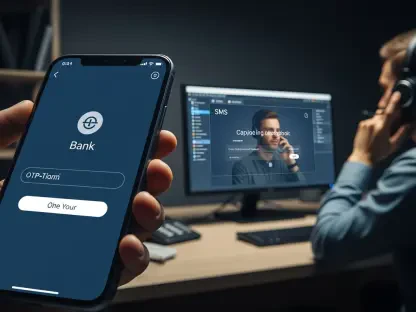Picture a call from your bank, the voice on the line sounding exactly like your trusted advisor, urgently requesting a transfer to secure your account. But what if that voice isn’t real? AI-generated deepfakes and synthetic speech have turned voice fraud into a chilling reality, eroding trust in every conversation. With billions of dollars lost annually to these scams, the stakes have never been higher. This feature dives into an innovative alliance between BT, a telecommunications titan, and Pindrop, a voice security pioneer, as they harness artificial intelligence to combat the very technology fraudsters wield.
The Alarming Rise of a Hidden Threat
Voice fraud has emerged as a silent epidemic in the digital age, with fraudulent calls now accounting for one in every 599 interactions. Pindrop’s latest data reveals a staggering statistic: one in 106 calls exhibits traits of deepfake technology, a tool that can replicate voices with uncanny precision. This isn’t just a nuisance; it’s a crisis that threatens personal security and corporate integrity across industries like finance and healthcare, where a single breach can cascade into devastating losses.
The sophistication of these attacks has outpaced traditional defenses, leaving both consumers and businesses vulnerable. Fraudsters exploit AI to mimic not just voices but also emotional tones and speech patterns, making detection nearly impossible without advanced tools. This growing menace underscores the urgent need for solutions that can keep up with the rapid evolution of cybercrime, setting the stage for groundbreaking interventions.
Why Voice Fraud Demands Immediate Action
The surge in voice fraud, with cases doubling in just a few years, marks it as the new frontier of cybercrime. Financial institutions alone report losses in the hundreds of millions due to scams where synthetic voices impersonate executives or clients. This threat exploits a fundamental human instinct—trust in a familiar voice—turning a strength into a critical weakness.
Beyond monetary damage, the erosion of confidence in communication channels poses a broader risk. Companies struggle to balance customer convenience with security, while individuals hesitate to answer calls, fearing deception. The urgency to address this issue cannot be overstated, as the ripple effects touch every corner of daily life, from personal interactions to corporate dealings.
Unpacking the BT-Pindrop Alliance
At the forefront of this battle stands a powerful partnership between BT and Pindrop, blending telecommunications reach with cutting-edge voice security. Pindrop’s flagship tools, such as Pindrop Protect and Pindrop Passport, integrate seamlessly into BT’s vast network, enabling real-time detection of synthetic voices. These solutions analyze thousands of acoustic signals and metadata points, often flagging fraud before a call even connects to a human.
This collaboration goes beyond mere technology; it’s a strategic move to safeguard regulated sectors like banking and government. A spokesperson from BT highlighted, “Integrating Pindrop’s AI allows us to protect customers without disrupting their experience, a balance critical in high-stakes industries.” The result is a dual benefit—enhanced security and streamlined authentication that cuts wait times for legitimate users.
The impact is already visible in early deployments, where call centers report a significant drop in fraud attempts. By using techniques like “Phoneprinting” and behavioral analytics, the system identifies anomalies unique to synthetic speech, offering a robust shield. This partnership exemplifies how AI can serve as both a weapon for fraudsters and a defense for the vulnerable.
Hard Numbers and Expert Voices
Pindrop’s research paints a grim picture of the current landscape, with fraudulent calls infiltrating even the most secure systems. Their data shows a sharp uptick in deepfake usage over recent years, projecting further growth if unchecked. Industry analysts echo this concern, noting that AI-driven defenses are no longer a luxury but a necessity in an era where fraud tactics evolve weekly.
A senior executive from Pindrop shared a sobering insight: “Voice fraud isn’t just about money; it’s about trust. Once that’s broken, no amount of technology can fully repair it.” This perspective drives the mission behind the partnership, emphasizing proactive measures over reactive fixes. The consensus among experts is clear—collaborations like this one are pivotal in staying ahead of cybercriminals.
Further reinforcing this urgency, case studies from financial sectors reveal how AI detection has thwarted multi-million-dollar scams. One instance involved a synthetic voice mimicking a CEO to authorize a transfer, only to be flagged by Pindrop’s system within seconds. Such examples highlight the tangible value of these innovations in real-world scenarios.
Lessons for Businesses and Individuals
While BT and Pindrop fortify enterprise networks, there are critical takeaways for everyone navigating this threat landscape. For individuals, recognizing red flags—such as unexpected urgency or odd speech pauses in calls—can serve as a first line of defense. Staying skeptical of unsolicited requests, even from familiar voices, is a simple yet effective habit to adopt.
Businesses, on the other hand, must prioritize voice security within their broader digital strategies. This means investing in AI-driven tools and training staff to spot potential fraud indicators. Partnering with trusted providers ensures that communication channels remain secure without sacrificing operational efficiency, a lesson drawn directly from this collaboration’s approach.
Another key insight is the need for continuous education on AI threats. As synthetic speech technology advances, so must awareness of its risks and countermeasures. Engaging with industry updates and leveraging expert resources can empower both companies and consumers to stay one step ahead of fraudsters in this ever-shifting battle.
Reflecting on a Path Forward
Looking back, the alliance between BT and Pindrop stood as a beacon of innovation in a time when voice fraud shook the foundation of trust in communication. Their combined efforts demonstrated that AI, often a tool of deception, could be repurposed as a guardian of authenticity. Each thwarted scam and secured call marked a small victory in a larger war against cybercrime.
The journey didn’t end there, though. It paved the way for broader adoption of AI-driven security across industries, urging companies to rethink how they protect their most human asset—voice. The challenge moving forward was to scale these solutions, ensuring that even small businesses and individuals could access defenses once reserved for giants.
Ultimately, the fight against voice fraud became a shared responsibility. Businesses were encouraged to integrate advanced tools into their systems, while consumers were prompted to remain vigilant and informed. As technology continued to evolve, the enduring lesson was simple yet profound: trust could be rebuilt, one secure conversation at a time.









